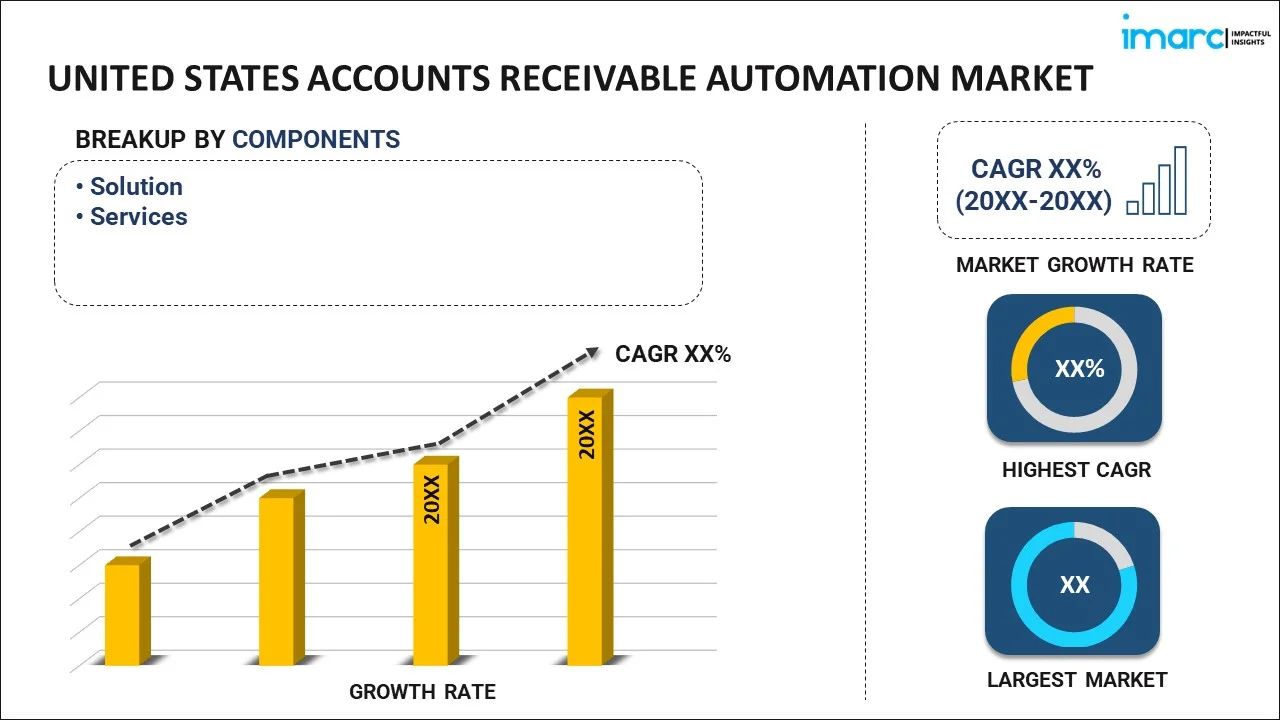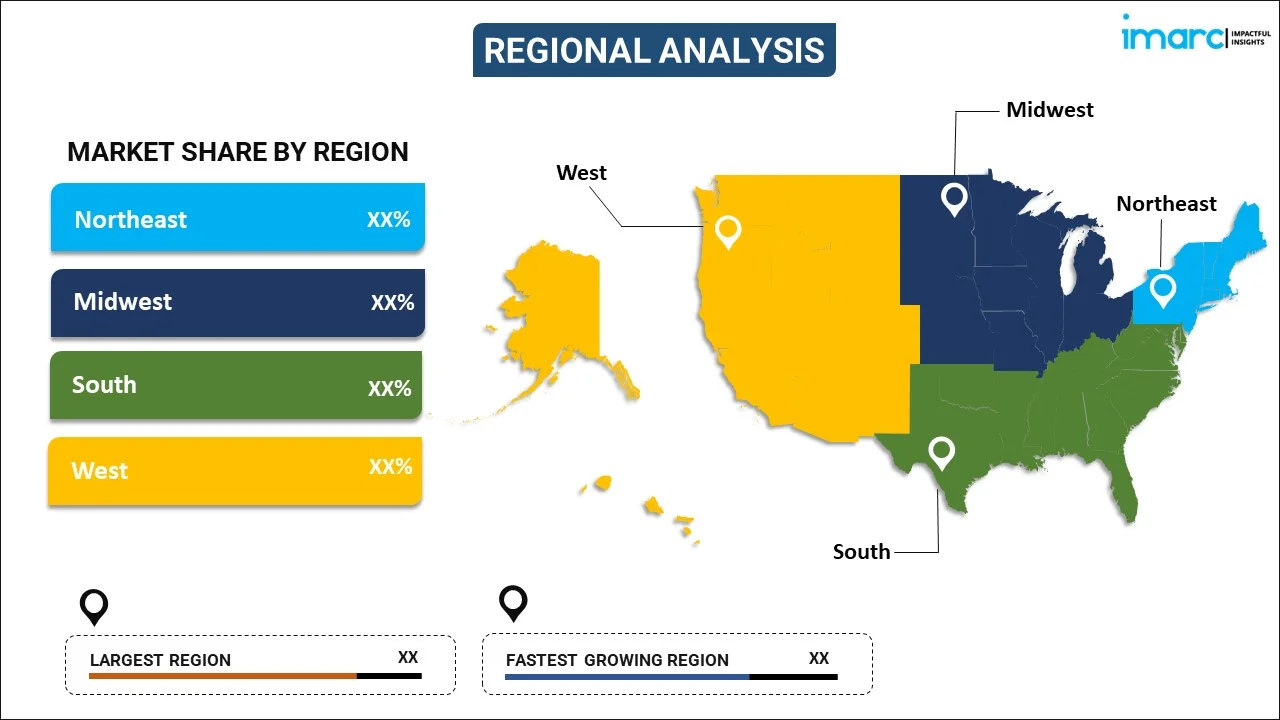
United States Accounts Receivable Automation Market Report by Component (Solution, Services), Deployment (On-premises, Cloud-based), Organization Size (Large Enterprises, Small and Medium-sized Enterprises), Vertical (Consumer Goods and Retail, BFSI, Manufacturing, IT and Telecom, Healthcare, Energy and Utilities, and Others), and Region 2024-2032
Market Overview:
United States accounts receivable automation market size is projected to exhibit a growth rate (CAGR) of 10.60% during 2024-2032. A paradigm shift in financial management practices, along with the widespread adoption of enhanced software solutions to automate tasks, is primarily driving the market growth across the country.
|
Report Attribute
|
Key Statistics
|
|---|---|
|
Base Year
|
2023 |
|
Forecast Years
|
2024-2032
|
|
Historical Years
|
2018-2023
|
| Market Growth Rate (2024-2032) | 10.60% |
Accounts receivable (AR) automation involves the utilization of technology and software solutions to streamline and enhance the management and collection of payments from customers. The process encompasses the automation of various tasks and workflows associated with accounts receivable, including the creation and dispatch of invoices, monitoring payments, overseeing customer accounts, and addressing overdue payments. Integration with existing accounting and customer relationship management (CRM) systems is a key feature of AR automation. These tools leverage advanced technologies like artificial intelligence (AI), machine learning (ML), and robotic process automation (RPA) to boost efficiency and accuracy in handling accounts receivable processes. The implementation of AR automation contributes to heightened efficiency, a reduction in manual errors, the facilitation of payment processing, improved management of cash flow, timely and precise communication leading to enhanced customer satisfaction, and a clearer insight into the performance of accounts receivable.
United States Accounts Receivable Automation Market Trends:
The United States accounts receivable automation market is experiencing a transformative surge driven by the adoption of advanced technology to streamline and optimize financial processes. This market revolves around the implementation of cutting-edge software solutions to automate tasks associated with managing and collecting payments from customers. A notable aspect of the U.S. accounts receivable automation market is its seamless integration with existing accounting and customer relationship management (CRM) systems. Additionally, leveraging artificial intelligence (AI), machine learning (ML), and robotic process automation (RPA), these solutions significantly enhance the efficiency and accuracy of accounts receivable processes, thereby acting as another significant growth-inducing factor. The benefits of adopting accounts receivable automation in the United States are multifold. It not only increases operational efficiency and minimizes manual errors but also expedites payment processing, optimizes cash flow management, and fosters improved customer satisfaction through timely and accurate communication. Moreover, it provides businesses with enhanced visibility into their accounts receivable performance, enabling strategic decision-making. As businesses across industries prioritize automation for improved financial agility, the United States accounts receivable automation market is poised for sustained growth over the forecasted period.
United States Accounts Receivable Automation Market Segmentation:
IMARC Group provides an analysis of the key trends in each segment of the market, along with forecasts at the country level for 2024-2032. Our report has categorized the market based on component, deployment, organization size, and vertical.
Component Insights:

- Solution
- Services
The report has provided a detailed breakup and analysis of the market based on the component. This includes solution and services.
Deployment Insights:
- On-premises
- Cloud-based
A detailed breakup and analysis of the market based on deployment have also been provided in the report. This includes on-premises and cloud-based.
Organization Size Insights:
- Large Enterprises
- Small and Medium-sized Enterprises
The report has provided a detailed breakup and analysis of the market based on the organization size. This includes large enterprises and small and medium-sized enterprises.
Vertical Insights:
- Consumer Goods and Retail
- BFSI
- Manufacturing
- IT and Telecom
- Healthcare
- Energy and Utilities
- Others
A detailed breakup and analysis of the market based on vertical have also been provided in the report. This includes consumer goods and retail, BFSI, manufacturing, IT and telecom, healthcare, energy and utilities, and others.
Regional Insights:

- Northeast
- Midwest
- South
- West
The report has also provided a comprehensive analysis of all the major regional markets, which include the Northeast, Midwest, South, and West.
Competitive Landscape:
The market research report has also provided a comprehensive analysis of the competitive landscape in the market. Competitive analysis such as market structure, key player positioning, top winning strategies, competitive dashboard, and company evaluation quadrant has been covered in the report. Also, detailed profiles of all major companies have been provided.
United States Accounts Receivable Automation Market Report Coverage:
| Report Features | Details |
|---|---|
| Base Year of the Analysis | 2023 |
| Historical Period | 2018-2023 |
| Forecast Period | 2024-2032 |
| Units | US$ Million |
| Scope of the Report | Exploration of Historical and Forecast Trends, Industry Catalysts and Challenges, Segment-Wise Historical and Predictive Market Assessment:
|
| Components Covered | Solution, Services |
| Deployments Covered | On-premises, Cloud-based |
| Organization Sizes Covered | Large Enterprises, Small and Medium-sized Enterprises |
| Verticals Covered | Consumer Goods and Retail, BFSI, Manufacturing, IT and Telecom, Healthcare, Energy and Utilities, Others |
| Regions Covered | Northeast, Midwest, South, West |
| Customization Scope | 10% Free Customization |
| Report Price and Purchase Option | Single User License: US$ 3699 Five User License: US$ 4699 Corporate License: US$ 5699 |
| Post-Sale Analyst Support | 10-12 Weeks |
| Delivery Format | PDF and Excel through Email (We can also provide the editable version of the report in PPT/Word format on special request) |
Key Questions Answered in This Report:
- How has the United States accounts receivable automation market performed so far and how will it perform in the coming years?
- What has been the impact of COVID-19 on the United States accounts receivable automation market?
- What is the breakup of the United States accounts receivable automation market on the basis of component?
- What is the breakup of the United States accounts receivable automation market on the basis of deployment?
- What is the breakup of the United States accounts receivable automation market on the basis of organization size?
- What is the breakup of the United States accounts receivable automation market on the basis of vertical?
- What are the various stages in the value chain of the United States accounts receivable automation market?
- What are the key driving factors and challenges in the United States accounts receivable automation?
- What is the structure of the United States accounts receivable automation market and who are the key players?
- What is the degree of competition in the United States accounts receivable automation market?
Key Benefits for Stakeholders:
- IMARC’s industry report offers a comprehensive quantitative analysis of various market segments, historical and current market trends, market forecasts, and dynamics of the United States accounts receivable automation market from 2018-2032.
- The research report provides the latest information on the market drivers, challenges, and opportunities in the United States accounts receivable automation market.
- Porter's five forces analysis assist stakeholders in assessing the impact of new entrants, competitive rivalry, supplier power, buyer power, and the threat of substitution. It helps stakeholders to analyze the level of competition within the United States accounts receivable automation industry and its attractiveness.
- A competitive landscape allows stakeholders to understand their competitive environment and provides an insight into the current positions of key players in the market.
Need more help?
- Speak to our experienced analysts for insights on the current market scenarios.
- Include additional segments and countries to customize the report as per your requirement.
- Gain an unparalleled competitive advantage in your domain by understanding how to utilize the report and positively impacting your operations and revenue.
- For further assistance, please connect with our analysts.
 Inquire Before Buying
Inquire Before Buying
 Speak to an Analyst
Speak to an Analyst
 Request Brochure
Request Brochure
 Request Customization
Request Customization




.webp)




.webp)












